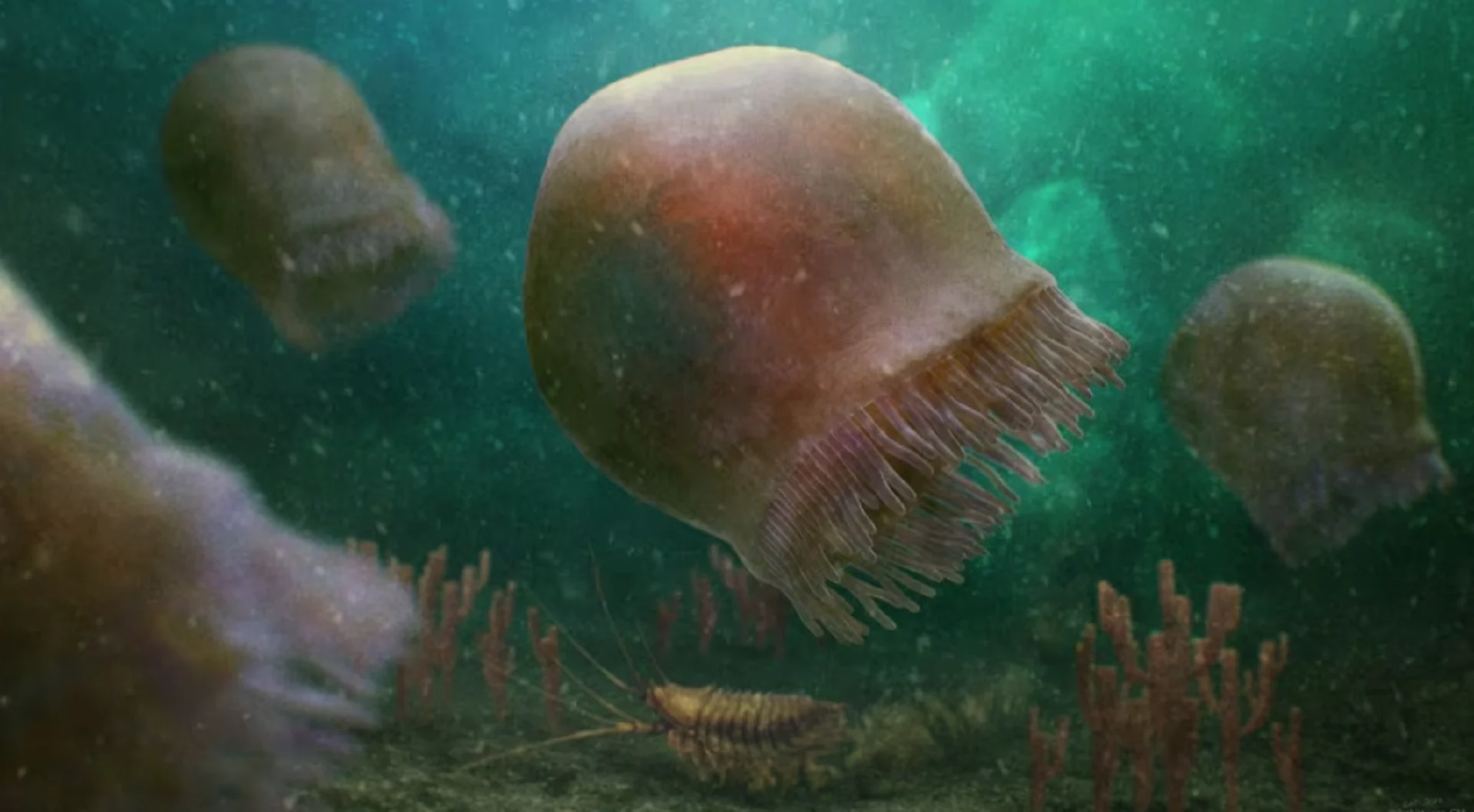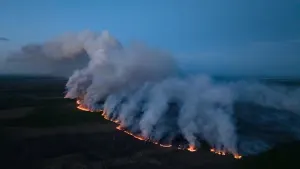
This jellyfish was the terror of the sea 500 million years ago

A smaller Burgessomedusa phasmiformis jellyfish is preserved above a larger specimen in this photo taken at the Burgess Shale fossil site in B.C. Tentacles can be seen on the left side of the larger specimen and the right side of the smaller. (Desmond Collins/Royal Ontario Museum)
The jellyfish had a bell about 20 centimetres high — as large as a loaf of bread — making it one of the largest creatures at that time, said Joe Moysiuk, a PhD student at the University of Toronto and the Royal Ontario Museum (ROM) who helped describe the species in a new study published Tuesday in the Proceedings of the Royal Society B.
The rectangular shape of the bell was similar to that of deadly, venomous, modern-day box jellies that live in northern Australian and Indo-Pacific waters, suggesting that the ancient jellyfish was also a fast and powerful swimmer.
"This may have been a pretty aggressive predatory species of jellyfish," said Moysiuk, who worked on the study with two other colleagues, Justin Moon and Jean-Bernard Caron.
Its bell was fringed with more than 90 tentacles, resembling those of the harmless moon jellyfish.
A couple of the fossilized jellyfish — among nearly 200 unearthed at the Burgess Shale — have been on public display as part of the Dawn of Life exhibit at the Toronto-based ROM since the exhibit first opened in 2021.
But this week, a name plate was added underneath: Burgessomedusa phasmiformis — their new official scientific name.
The name means "the Burgess Shale jellyfish with a ghostly form," Moysiuk explained. "Specifically, we thought it looked like the ghost from the game Pac-Man."
Is it really the oldest jellyfish?
Frankie Dunn, a senior researcher at the Oxford University Museum of Natural History in the U.K., called the new discovery "an amazing fossil."
Dunn published a discovery last year of an even older creature that was technically a jellyfish, but not as most people know them.
Jellyfish are related to corals, beginning their lives as coral-like polyps that have a stalk and are stuck to things like rocks or the sea floor — a stage where very ancient jellyfish relatives may have remained for their whole lives.

Models in a collection room of the Royal Ontario Museum show the diversity of ancient invertebrates found in the Burgess Shale. (Evan Mitsui/CBC)
The fossil Dunn studied, Auroralumina attenboroughii, was a huge jellyfish polyp that lived 557 million to 562 million years ago, during the Ediacaran period, before the Cambrian.
It wasn't clear if Auroralumina ever matured into a swimming jellyfish, Dunn said.
As modern jellyfish polyps age, they metamorphose into a star- or flower-like larvae called ephyra, which can swim, before becoming the adults we all recognize as jellyfish.
Dunn said there have also been some ephyra fossils about 18 million years older than the Burgessomedusa found in the Burgess Shale, which means the new fossil isn't technically the earliest free-swimming jellyfish.
"So where, exactly, the [adult] jellyfish part of the life cycle evolved along the lineage, we don't know," she said.
According to Moysiuk, the Burgessomedusa shows that jellyfish had already evolved their complex life cycle by the Cambrian period.
Some researchers had previously described what they believed to be Cambrian adult jellyfish fossils from the U.S. and China. But Moysiuk said those were poorly preserved. He and his colleagues now think those fossils are actually comb jellies — a completely different group of animals from jellyfish.
Dunn is convinced that Burgessomedusa, on the other hand, is what the researchers think.
"What's really exciting about this new fossil is that it very clearly does represent the jellyfish part of the life cycle, something which is really rare in the fossil record," said Dunn.
"This is the first adult that we've seen — and it's very clearly a jellyfish. It has all of the features that I would expect to see in a jellyfish. So it's really exciting to see this fossil reported."

Paleontologist Joe Moysiuk holds a fossilized jellyfish from the Burgess Shale in the collection room of the Royal Ontario Museum in Toronto on July 31, 2023. The museum has more than 200 specimens of the species. (Evan Mitsui/CBC)
A first for the Burgess Shale
The new jellyfish species is the first ever found in the Burgess Shale, a 505-million-year-old fossil bed in the mountains of B.C. considered by UNESCO to be one of the most important in the world. That's because of the amazing preservation there of fossils of a huge diversity of animals from the Cambrian, a time when animal diversity exploded.
Among the animals that lived in the shallow sea at that time were trilobites, fish, comb jellies, acorn worms, and many weird and wonderful creatures unlike any still alive today.
The new jellyfish discovery, Moysiuk said, "helps to fill in one more gap in our picture of the diversity of organisms that were living in the Cambrian."
The study was funded with University of Toronto doctoral fellowships, an Ontario Graduate Scholarship, and a grant from the Natural Sciences and Engineering Research Council.
This article was written for the CBC by Emily Chung. Header image: An artistic reconstruction shows a group of Burgessomedusa phasmiformis swimming 505 million years ago in the Cambrian sea, where it was believed to be one of the largest predators. (Christian McCall)









